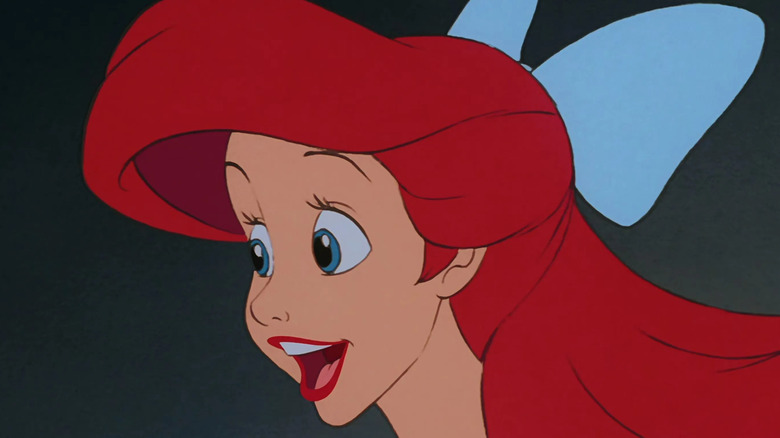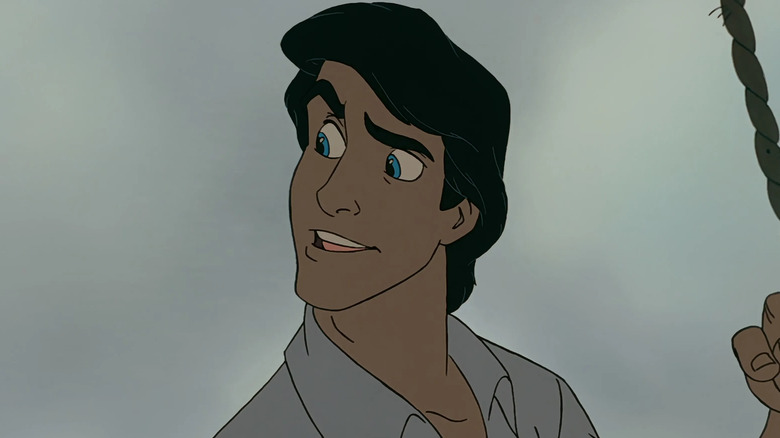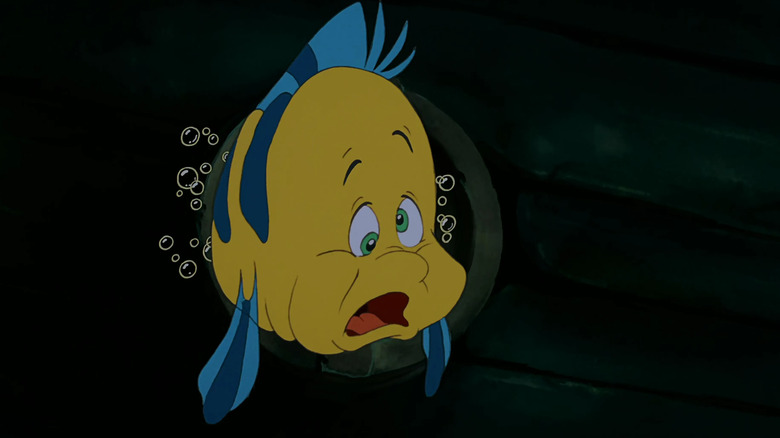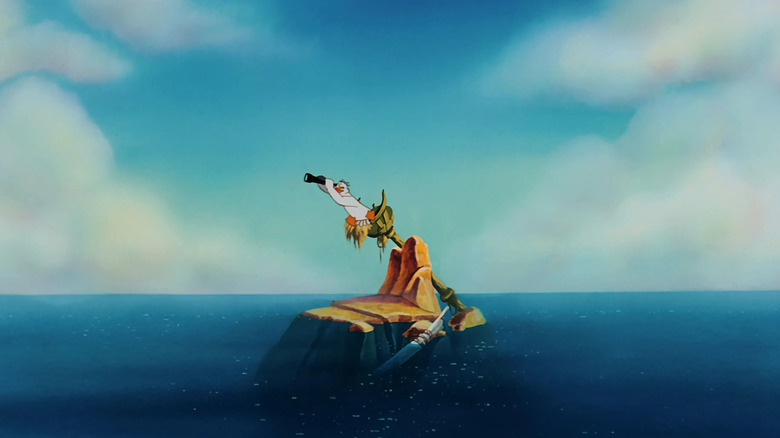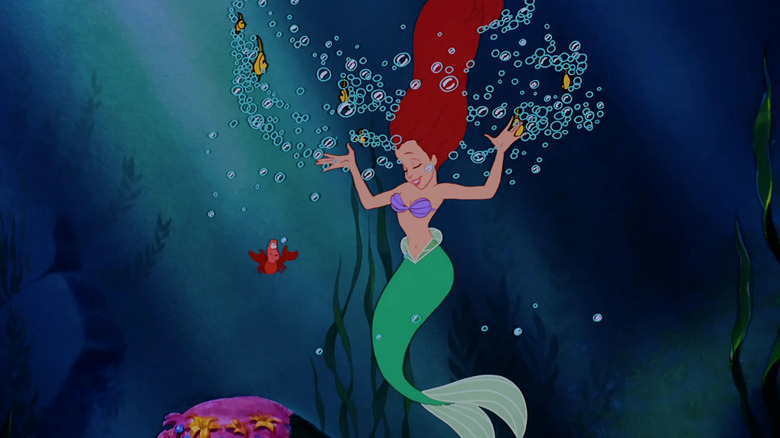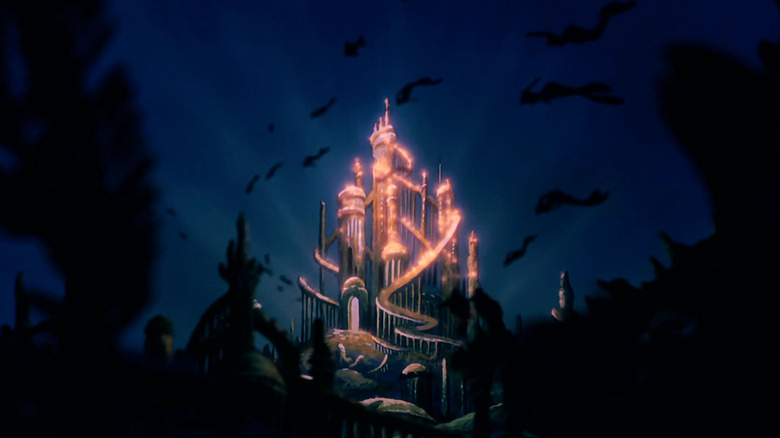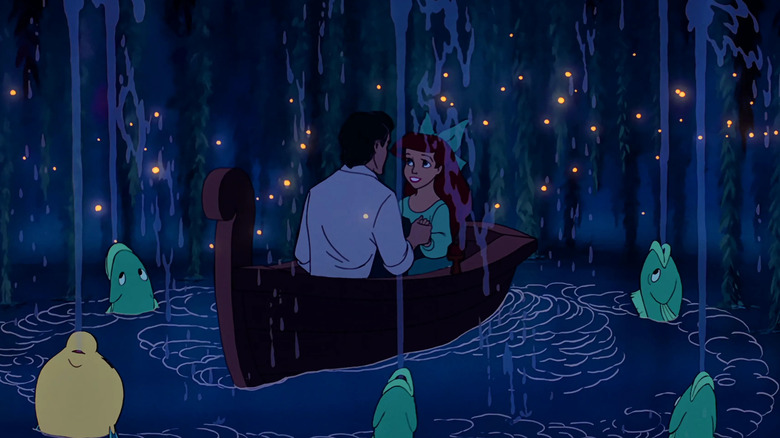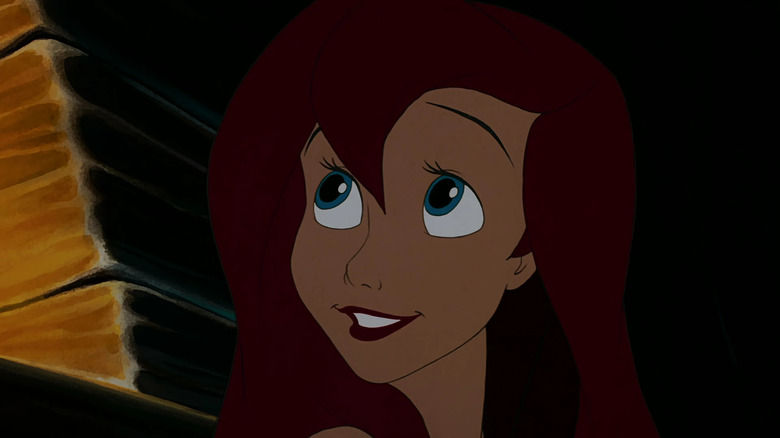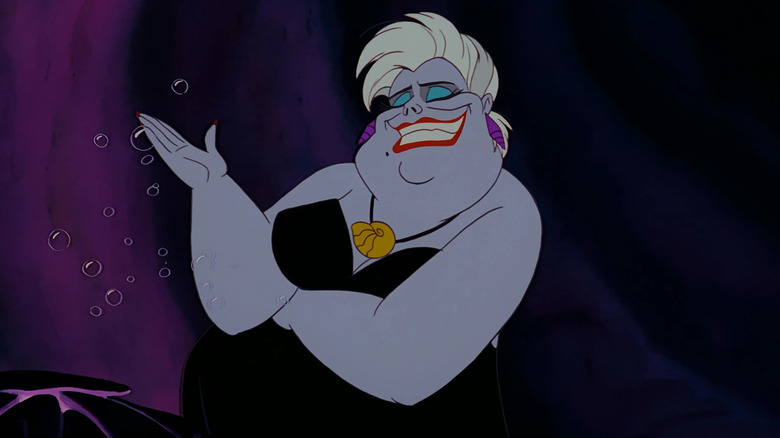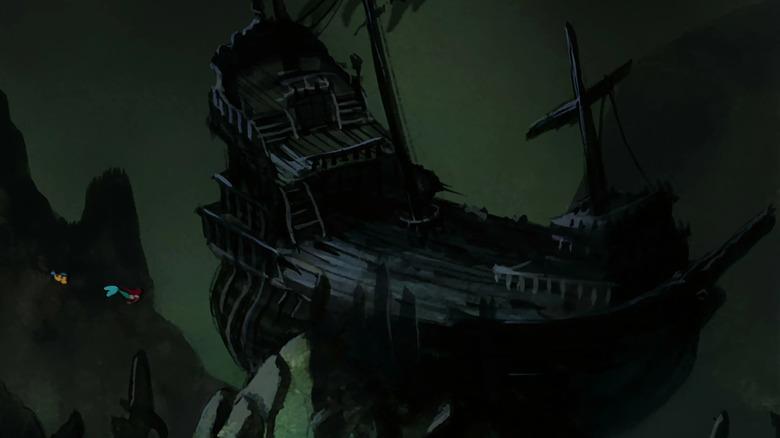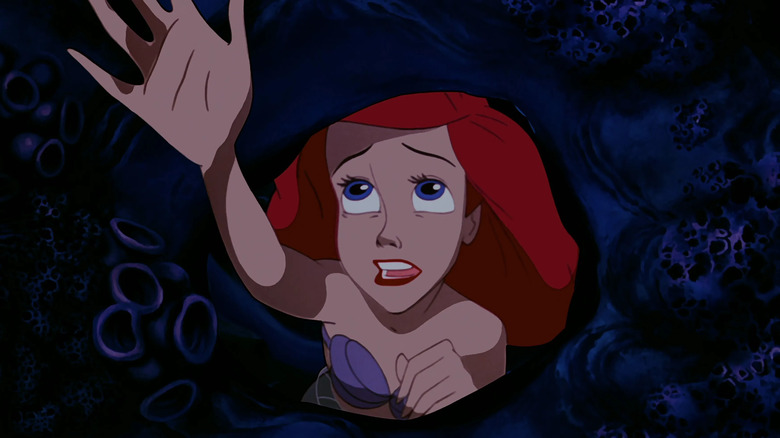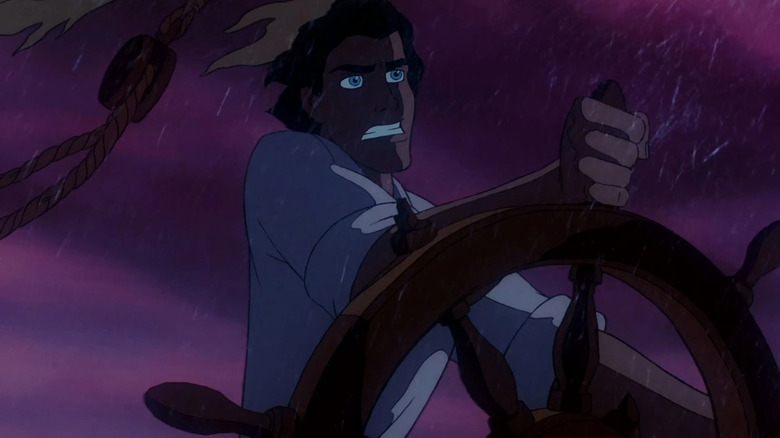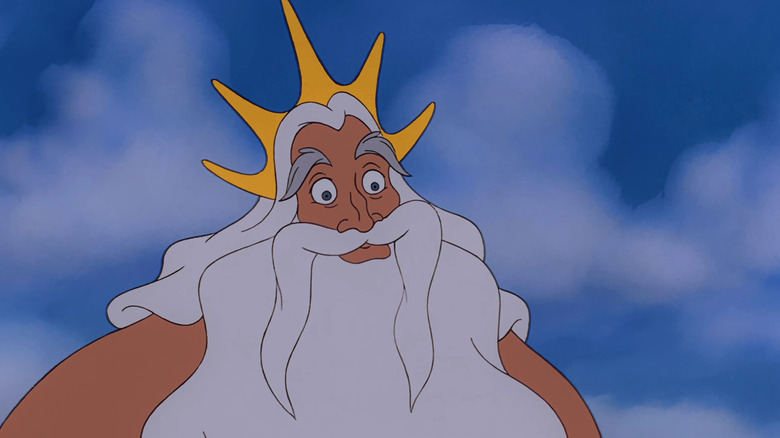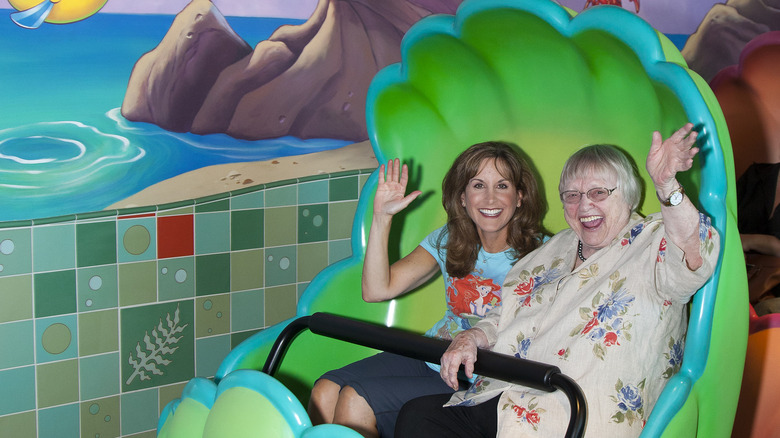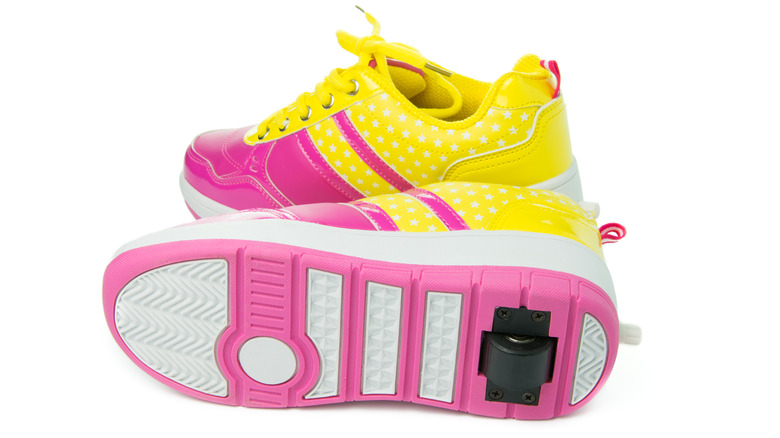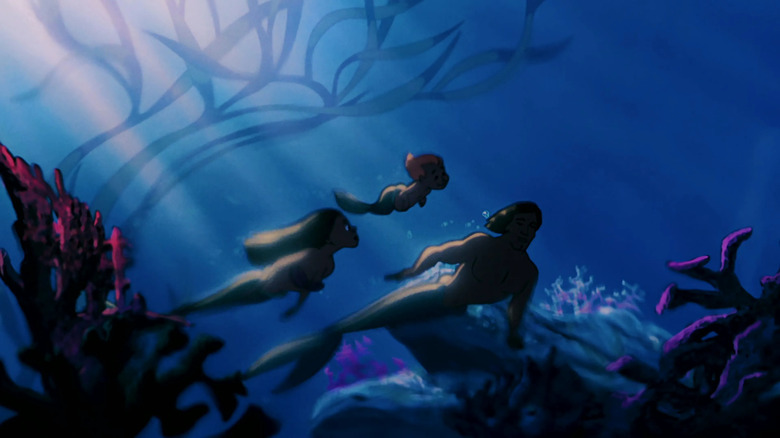The Untold Truth Of Disney's The Little Mermaid
"The human world? It's a mess. Life under the sea is better than anything they've got up there!" These words prelude "Under the Sea," one of the most iconic songs in Disney history. The ditty won an Oscar for Best Song in 1990, an honor that is indicative of a period of energy, renown, and revitalization for Walt Disney Animation Studios.
"The Little Mermaid," which featured "Under the Sea" on its now classic soundtrack, brought the struggling movie factory back to life by initiating the "Disney Renaissance," as described by Chris Pallant in "Demystifying Disney: A History of Disney Feature Animation." At the time of its release in 1989, "The Little Mermaid" was new, but felt old. Its characters were modern, yet vintage. This was a new kind of fairytale, but one very much still rooted in the style of the greats before it. Ultimately, "The Little Mermaid" would create a new pattern for everything that followed in the world of Disney animation.
It cannot be overstated how much one project changed Disney — and a generation of moviegoers — forever. Discover how a mermaid, talking crab, and sea witch did so in the untold truth of Disney's "The Little Mermaid."
The original pitch was rejected
While these days "The Little Mermaid" can be looked at as an indispensable entry in Disney Animation's vast library of classics, not everyone was initially convinced of its destiny or power. The 2006 documentary "Treasures Untold: The Making of The Little Mermaid" sheds light on the origins of the story's adaptation with the studio. In the mid-1980s, Disney was under new leadership, which included studio chairman Jeffrey Katzenberg. He invited employees to pitch ideas for new animated feature films in a meeting he called "the gong show." If a pitch was poorly received, Katzenberg banged an actual gong in the room.
During one meeting, animator Ron Clements pitched an idea: an adaptation of the Hans Christian Andersen fairy tale "The Little Mermaid." Katzenberg didn't like it, and "The Little Mermaid" got the gong. Part of his reasoning for the rejection was because Disney was already producing a live-action movie about a mermaid, 1984's "Splash." Thankfully, Clements had also delivered a story treatment document in addition to giving his presentation. Upon further review of that treatment the next day, Katzenberg changed his mind. The movie was greenlit, Clements was assigned as a director along with John Musker, and the rest is history.
Walt Disney tried to make The Little Mermaid in 1941
Almost 50 years before Disney Animation finally produced "The Little Mermaid," Walt Disney explored the story as a potential animated project. Directors Ron Clements and John Musker share in "The Story Behind the Story" DVD bonus feature that they unearthed some of this concept development in the Walt Disney Archives when they started their own "Little Mermaid" journey in the '80s.
From what they could decipher from artwork dated 1941, Disney had commissioned one of his artists to create paintings showing what an animated version of the Hans Christian Andersen fairytale could look like as a Disney "featurette." At the time, the studio was fond of assembling several animated short films of around 15-20 minutes each into full-length feature compilation movies. These "package films," as they came to be called, eventually included Disney projects such as 1942's "Saludos Amigos" and 1947's "Fun and Fancy Free," among others (via Jumpcut Online). It's interesting to imagine a version of "The Little Mermaid" existing among this vintage collection of wartime Disney cartoons.
Clements and Musker discovered that both the original Andersen narrative and Disney's 1941 pass at an adaptation were decidedly darker than the story they wanted to tell. For one, the mermaid doesn't end up with the prince in the end, but instead her soul is dissolved into the ocean. They found the 1941 artwork fascinating, but weren't attached to its storytelling choices.
The Little Mermaid was made in an industrial park
At the time "The Little Mermaid" was created in the 1980s, Disney Animation didn't have the best track record. However, other areas of Disney's film productions were booming under the management of new CEO Michael Eisner, new CFO Frank Wells, and new studio chairman Jeffrey Katzenberg (via The NY Times). The documentary "Treasures Untold" unearths a big change that happened during this transition of power.
Disney's live-action films were growing, which meant that these divisions needed more office space. So, something had to be removed from the legendary Walt Disney Studios lot in Burbank, California, which had been the headquarters of the company since 1940, to make room for these productions. Despite the fact that the lot was where animated movies had been made since "Pinocchio," animation got the boot.
The entire animation staff moved off campus to a warehouse and collection of trailers next to a bowling alley in nearby Glendale. While the new digs were far from glamorous, Peter Schneider, who was president of Disney's animation division at the time, says the move was "the best thing that could have happened to the animators." Freed from the looming pressure of Disney's former glory that had haunted the previous offices, filmmakers were now left to define their own style, which would usher in a new renaissance for Disney Animation.
The animation staff returned to the studio lot in 1994 with a new building all their own, where Disney animated movies are still made today.
Making the movie was a crash course in musical theater
Lyricist Howard Ashman also served as executive producer of "The Little Mermaid." Ashman came from a background in Broadway theater, and brought with him a genius storytelling strategy that changed Disney Animation forever, as shown in the "Howard's Lecture" bonus feature on the Blu-ray for "The Little Mermaid."
Some Disney animated movies in the 1980s had songs in them, but the movies weren't necessarily musicals. Ashman not only sought to make "The Little Mermaid" a more traditional musical film, but also to educate Disney animators about the mechanics of how Broadway incorporates songs into shows. He did this during a lunchtime lecture that would go down as a defining moment in Disney history.
Ashman went through every song in "The Little Mermaid" and shared how each number wasn't just there as filler. Instead, every song existed to move the story forward in some way. If done right, Ashman explained, the story should make no sense if the songs are removed because they are essential to the narrative.
Furthermore, Ashman insisted that the words or lyrics are presented in song form out of necessity. The character cannot express themselves in the same way through spoken dialogue. So, to truly vocalize what they feel, they must sing it. In studying how the dialogue transitions into melodized verse in "Part of Your World," "Under the Sea," and practically every song in "The Little Mermaid," one can see how Ashman infused this technique marvelously into the film.
The film used animation both old and new technology
"The Little Mermaid" was released in 1989, which placed it at an intersection of different eras of filmmaking technology and led to its use of both old and new animation techniques. Directors Ron Clements and John Musker elaborate on the unique technological challenges the crew faced in the film's audio commentary.
Clements and Musker share that for the establishing shot of the kingdom of Atlantica, the animators used the long-abandoned MultiPlane camera for the first time since 1967's "The Jungle Book." The MultiPlane camera allows a shot in an animated film to push forward through several layers of depth. The movie also revived the practice of live-action reference, which is the art of filming actors performing the scenes in pantomime for animators to study as reference. This technique was used often in the early days of Disney Animation, but hadn't been utilized for a while prior to "The Little Mermaid."
At the same time as it honored tradition, "The Little Mermaid" was also on the cutting edge of new innovations in the field. The shot of the merpeople waving goodbye at the end of the film was the first shot in any Disney movie to use a new system called CAPS, which stands for "Computer Animation Post-production System." The system would become the norm going forward.
While the animation in "The Little Mermaid" is hand-drawn, viewers may notice that some elements are early adopters of computer-generated imagery. Prince Eric's staircase and horse-drawn carriage are two such examples.
The movie saved Disney Animation
"The Little Mermaid" hailed the arrival of a bold new generation of Disney animated classics, which was no accident. The documentary "Treasures Untold" reveals that from the beginning, "The Little Mermaid" filmmakers set out with the daunting task of creating a movie that could sit comfortably alongside the masterpieces of Disney's golden age like "Pinocchio" or "Cinderella." No pressure, right?
In a way, they had no other choice. As unthinkable as it now may seem, if "The Little Mermaid" failed, Disney Animation might have been gone forever. The output of the animation studio in the '80s prior to "Mermaid" was simply not worth it. Animator Andreas Deja, who brought King Triton to life, remembers thinking, "Is this the beginning of the end?"
In the documentary "Waking Sleeping Beauty," Jeffrey Katzenberg, chairman of Walt Disney Studios at the time "The Little Mermaid" was in production, says the artists were stalled by the legacy of their deceased founder. The question Katzenberg kept hearing in every discussion was "What would Walt do?" This mantra had resulted in nearly two decades of uninspiring duds since Walt passed in 1966. New to Disney and responsible for its future, Katzenberg realized they needed a new strategy: "We're not Walt. We need to be us."
"The Little Mermaid" not only saved the art form that is the Disney animated movie, but also kicked off a wave of new all-time classics for the studio.
The crew found their Ariel in an unexpected place
Whoever landed the role of Ariel needed to have a voice so beautiful that it would make sense for Prince Eric to embark on a journey to find its source: the person who saved his life and sang to him on the shore.
Lyricist and executive producer Howard Ashman didn't have to look far, as shared in the documentary "Howard." Prior to joining the crew of "The Little Mermaid," Ashman developed musicals in New York City, like "Little Shop of Horrors" and a somewhat forgotten show called "Smile." Unfortunately, "Smile" wasn't a hit when it debuted on Broadway in 1986, but it did make its mark in showbiz history, as it was where Howard Ashman first met Jodi Benson, who played Doria in the show.
When it came time to cast Ariel, Ashman encouraged Benson to audition, and she landed the role of a lifetime as the newest Disney princess. Speaking to ComingSoon.net to celebrate the 30th anniversary of "The Little Mermaid" in 2019, Benson reflected on Ariel's legacy: "She reached for the impossible and it gave kids hope to know that they could go after things that seemed to be difficult or unattainable." Benson continued, "It's just such an honor, I'm so thankful, so grateful to be a small piece of this puzzle and I'm excited to see how all of our princesses and their impact have affected so many generations."
Ursula was inspired by a drag queen
Disney artists created many designs as potential options for every character in "The Little Mermaid," and the documentary "Howard" reveals that the villain who would steal Ariel's voice found inspiration from an unlikely source.
There were many different variations of Ursula hung on a wall for review, and the one selected as the character's final look was drawn by storyboard artist Roger Allers — and it was inspired by Divine the drag queen. Divine's appearance and body language informed Ursula's design and animation moving forward.
Directors Ron Clements and John Musker share in the movie's audio commentary that in terms of oceanic inspiration, animators studied reference footage of octopi from Disney's 1959 nature film "Mysteries of the Deep." However, Ursula's voice actor, Pat Carroll, is quick to point out that Ursula is not, in fact, an octopus. In the documentary "Treasures Untold," Carroll clarifies that Ursula is a squid with six tentacles, not eight, because that it makes her less expensive to draw!
Carroll continued to voice Ursula in spin-off projects over the years, including television projects and theme park attractions. She reprised the villainous role as recently as 2020 in "The Wonderful World of Mickey Mouse." In the episode "Keep On Rollin'," Ursula makes a surprise appearance and teams up with Mickey's rival, Pete, to overthrow a '70s-style roller skating rink. It's bonkers in the most amazing way and you simply must watch it on Disney+ immediately.
Is The Little Mermaid part of a connected Disney universe?
Disney is known for sneaking "Easter eggs" into their movies, which are nods to other movies and characters hidden in the details. "The Little Mermaid" is no different, and in the movie's audio commentary, directors Ron Clements and John Musker point out a tribute to Disney heritage found in one of the first moments of the film.
After the song "Fathoms Below" and the subsequent opening credits, King Triton enters a concert hall to the applause of the merpeople of Atlantica. As Triton's carriage swoops over the crowd, sharp-eyed viewers may notice three Disney originals among the masses: Mickey Mouse, Donald Duck, and Goofy. While their appearance is nothing more than a quick surprise, you can't help but wonder what kind of adventure might've led the trio to Atlantica!
There's one conspiracy theory connected to "The Little Mermaid" that has a lot more lore behind it. Some fans have postulated that the shipwreck Ariel explores was the crashed vessel of Anna and Elsa's parents, who were on their way to Rapunzel and Flynn's wedding before they landed on the shores of Africa and later gave birth to Tarzan (via The Sun). Although the events of "Frozen 2" ultimately debunk this backstory, it is fun to imagine it (and it definitely would have made a wild season of "Once Upon a Time").
Part of Your World almost got deleted
One of the most iconic moments from "The Little Mermaid" is when Ariel sits in her grotto and sings about her dream of being "where the people are." The song, "Part of Your World," is the core of the film and has since become a legendary entry in the Disney songbook. But it almost didn't make the final cut. The documentary "Treasures Untold" lays out the drama that unfolded surrounding the fight to keep the song in the movie.
During an early test screening, kids restlessly squirmed during Ariel's big song, which led Walt Disney Studios chairman Jeffrey Katzenberg to demand that "Part of Your World" be removed. However, the filmmakers disagreed. Glen Keane, the supervising animator of Ariel, says deleting the song was "the last thing I thought possible." This was the heartbeat of the entire story, when the audience connects most deeply with what Ariel wants. It allows empathy for her motivations throughout the whole film. Keane pleaded with Katzenberg to give the song one more chance.
Katzenberg agreed to an additional screening, where thankfully no kids squirmed! With a laugh, the executive reflects that his error of judgment was in hindsight "truly and deeply humiliating."
For good measure, the animators added Sebastian into the scene so that as Ariel sang, the camera could occasionally cut away to visual gags of the crab comically interacting with some of Ariel's collection of "gadgets and gizmos aplenty" and keep younger audiences more interested during the song.
Needs more Die Hard
When you watch "The Little Mermaid," the first thing that comes to mind probably isn't Bruce Willis' Christmastime thriller. But believe it or not, "The Little Mermaid" directors Ron Clements and John Musker drew inspiration from "Die Hard," which they discuss in the film's audio commentary.
During an early review of the film's climactic battle, in which Ursula dies and Ariel regains her voice, the action just wasn't melding together. One executive gave instructions to rework the entire sequence, saying it "needed more 'Die Hard.'" Filmmakers suddenly found themselves asking the question, "How do we get 'Die Hard' into 'The Little Mermaid'?" Not exactly what you'd expect them to be pondering when finishing up a movie about a seaside fairytale kingdom.
They ended up leaning into more of an action-film sensibility and arrived at the framework we're familiar with today — a storm at sea, Ursula growing huge, and Prince Eric smashing a ship into her.
The final scene almost had no dialogue
One of the most emotional moments in "The Little Mermaid" comes towards the end of the film. As King Triton reflects on everything that's transpired and the new things he's learned about Ariel, he considers how his judgment may have been in error. He talks things over with Sebastian before concluding, "I guess there's just one problem left." "What's that, your majesty?" Sebastian asks. Triton replies, "How much I'm going to miss her." He then grants Ariel her wish: She becomes human, and can live on land with Eric.
The scene is played softly and poignantly, and it goes for the heartstrings of audience members' own parent/child relationships. But it almost didn't have any of this dialogue at all. Directors Ron Clements and John Musker share in the movie's audio commentary how lyricist and executive producer Howard Ashman elevated the scene to a new level.
Initially, the exchange between Triton and Sebastian, and in turn the subsequent transformation of Ariel, didn't have any spoken lines. The emotion was instead communicated through the characters' facial expressions. As talented as Disney animators may be, the crew felt like the nonverbal interaction didn't pack the punch they were hoping for. Ashman volunteered to give a pass at writing some dialogue for the scene, which ended up staying in the film.
Disneyland shelved its Little Mermaid ride for years
Disney theme parks offer the opportunity to be immersed into the worlds of favorite Disney films. Considering how beloved "The Little Mermaid" is, it might seem like a no-brainer to adapt the movie into a theme park attraction. While the film eventually received a ride all its own, it faced some hurdles to get there.
In the early 1990s, Walt Disney Imagineering developed a family-friendly ride for Disneyland that would tell the story of "The Little Mermaid" through music, animatronics, and special effects. The concept was eventually abandoned, and Imagineers went on to shed light on the "lost" ride for the 2006 DVD reissue of "The Little Mermaid" in a special feature called "Behind the Ride That Almost Was." Designers talked about how much they loved working on the attraction and wish it could have been built. Little did they know, it would.
In 2007, Disney announced that it would actually build the long-lost attraction, now dubbed "Ariel's Undersea Adventure," at Disneyland's sister park, Disney California Adventure. In 2009, the company revealed the ride would also be built at Walt Disney World in Florida (via The Orlando Sentinel).
While mostly the same, the completed version of the ride is a little different from the iteration developed in the '90s. The main difference is that in the finished product, guests travel on the ground. In the former version, the clamshell-shaped ride vehicle was suspended from the ceiling, much like the Disneyland classic "Peter Pan's Flight."
On Broadway, the cast wore Heelys
"The Little Mermaid" followed in the footsteps of Disney siblings "Beauty and the Beast," "The Lion King," "Tarzan," and "Mary Poppins" when it made the leap to Broadway in 2008 (via New York Theater Guide). Among other challenges in adapting the beloved animated movie to the stage was the story's setting. How would the show effectively communicate that the characters were underwater? In the movie, animators had drawn flurries of bubbles around characters as they moved to show that they were underwater. How does that translate to a Broadway stage?
Choreographer Stephen Mear found the surprising solution in Heelys, the everyday shoe that doubles as a makeshift rollerblade. "We didn't want wires, because once you've got wires ... there is no choreography, you can only swing," Mears told NPR. But with Heelys, Mears continued, "you can dance, you can pirouette, you can jump — and then, suddenly, you can just glide somewhere else." And so it was that the entire cast of the Broadway run of "The Little Mermaid" wore Heelys to emulate the ebb and flow of living in the ocean.
The filmmaking team's legacy lived on with Disney
Several creative leaders who brought "The Little Mermaid" to life in 1989 would go on to have long careers developing more Disney stories. Directors Ron Clements and John Musker became a dynamic directorial pair, who would later direct 1992's "Aladdin," 1997's "Hercules," 2002's "Treasure Planet," 2009's "The Princess and the Frog," and 2016's "Moana."
Score and song composer Alan Menken would have an illustrious career writing some of the most beloved Disney melodies of all time. Following "The Little Mermaid," Menken wrote score and songs for 1991's "Beauty and the Beast," 1992's "Aladdin," 1995's "Pocahontas," 1996's "The Hunchback of Notre Dame," 1997's "Hercules," 2007's "Enchanted," and 2010's "Tangled," among others. Menken and longtime collaborator Stephen Schwartz will write music for "Disenchanted," the 2022 sequel to "Enchanted" (via Broadway World). Menken is also working with Lin-Manuel Miranda on new songs for the 2023 live-action remake of "The Little Mermaid" (via Variety).
Unfortunately, one of the brilliant creative minds behind "The Little Mermaid" died not long after the film debuted. Lyricist and executive producer Howard Ashman passed away from HIV/AIDS in 1991 (via The NY Times). Prior to his death, he also wrote songs for "Beauty and the Beast" and "Aladdin." His life's story is shared in the biographical documentary "Howard" on Disney+.
